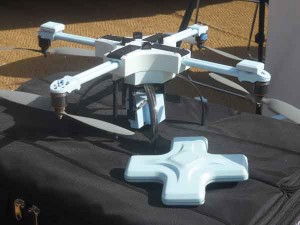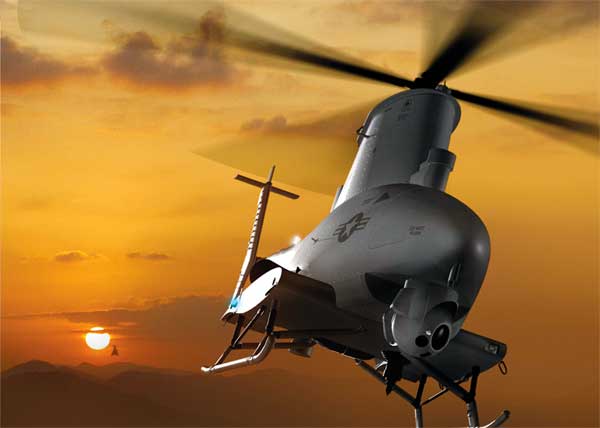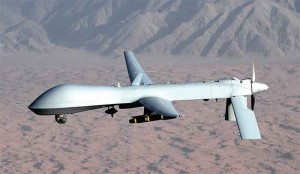The Indian Armed Forces operate nearly 150 mid-sized UAVs and many more handheld ones. India needs to push its ‘Make in India’ initiative for UAVs. Mumbai and New Delhi police are on the verge of acquiring UAVs. Aviation may come to the rescue of India’s dismal population-to-police ratio of 130 to every 1,00,000. The Hindustan Aeronautics Limited (HAL) along with DRDO’s Aeronautical Development Establishment (ADE) and National Aeronautical laboratory (NAL) Bangalore have developed mini and micro UAVs of three-kilogramme class. HAL designers are working on eight to ten kilogramme UAVs, which are expected to receive certification by early 2016. India’s indigenous capability has to be built up through a leapfrog by joining up with Israel, the world leader in UAV technology.
The entire concept of aerial warfare will see a change as UAVs become a part of all our day-to-day chores…
Whether tiny quadcopters that fly within a few hundred feet of their operator or huge winged craft piloted via satellite thousands of miles away, Unmanned Aerial Vehicles (UAVs) are taking to the skies in ever increasing numbers for a variety of applications. The exotic military reconnaissance UAVs of Iraq and Afghanistan War have now grown in numbers and sophistication and are now undertaking full-fledged combat engagements and ground strikes in near autonomous operations.
In April 2013, a BAE Systems Jetstream, a standard commercial propeller plane converted into an UAV research aircraft, autonomously flew an 805-km journey without a pilot onboard heralding a huge revolution in civil aviation. The main difference between this and hundreds of other UAV projects was that this was an unmanned airliner. UAVs are already being employed as eye-in-the-sky in roles such as policing, law enforcement, border control, sea lane monitoring, traffic control, crime scene photography, searching for missing persons, monitoring wildfires and combating drug trafficking. They could replace hundreds of CCTV cameras. The applications are as wide as human imagination.
The entire concept of aerial warfare will see a change as UAVs become a part of all our day-to-day chores and the day will come when we may be passengers onboard an aircraft without a conventional cockpit.
The era of UAVs began with the concerns of the United States Air Force (USAF) over losing pilots in hostile territory. This was more so after a U-2 was shot down over the Soviet Union in 1960. UAVs were first used in Vietnam. Israel developed the first UAV after the 1973 Yom Kippur war. UAVs helped Israel completely neutralise the Syrian defences in the beginning of 1982 Lebanon War in the famous Bekka Valley operation. UAVs were used in the 1991 Gulf War.
Initial generations were primarily for surveillance but others such as General Atomics MQ-1 Predator were armed with AGM-114 Hellfire air-to-ground missiles.
The use of UAVs typically falls into six functional categories – Target and Decoy, Reconnaissance, Combat, Logistics, Research and Development, Civil and Commercial.
Military Applications
Unmanned aircraft are already taking off and landing autonomously including on a moving aircraft carrier (Northrop GrummanX-47B). With autonomous aerial refuelling, UAVs can remain on station for months. Lockheed Martin’s UCLASS drone ‘Sea Ghost’ looks rather like a stealth bomber and is expected to carry 1,000-lb class weapons. Boeing’s Phantom Eye is used as an eye in the sky in battle zones. It is a High Altitude Long Endurance (HALE) vehicle that can spend over four days in continuous flight. The US has already modified F-4s and F-16s to fly them remotely. In France, Dassault leads a multi-nation delta wing UCAV ‘Neuron’ project the size of a Mirage 2000.
The US Army’s dramatic shift to a nearly all-unmanned flight over the next three decades is embedded in the UAS roadmap…
UK’s Strategic Unmanned Air Vehicle (SUAVE) programme ‘Taranis’ is headed by BAE Systems and is partnered by GE Aviation, RollsRoyce and QinetiQ. This will be a supersonic autonomous stealth bomber with intercontinental range. US Department of Defense (DoD) Hypersonic (Mach 6) Strike Bomber is likely to be optionally manned. The US Army’s dramatic shift to a nearly all-unmanned flight over the next three decades is embedded in the UAS roadmap. USAF’s vision document indicates that by year 2047, every mission including heavy lift would be unmanned.
UAVs have become too attractive and potent a military asset for any significant power to ignore. The USAF has 300-plus active Global Hawk, Predator and Reaper drones in its inventory. That number is expected to grow to 420 by fiscal 2017. Since 2011, the USAF has been training more UAV pilots than fighter and bomber pilots combined.
UAVs are known to be best for “Dull (long endurance), Dirty (chemical and nuclear sampling) and Dangerous (strikes on heavily defended targets)” missions. UAVs have much lower training costs and can best concentrate on ISR, close air support and take on some strike missions while air superiority could be handled by manned fighters. Manned aircraft continue to be better in dynamic environment. Unmanned Combat Aerial Vehicles (UCAV) can perform the Suppression of Enemy Air Defence (SEAD) mission and pre-emptive strikes ahead of main force package.
UAVs operate at a fraction of the total Life Cycle Cost (LCC) of manned systems. Mixed manned and unmanned formations, with airborne crew controlling swarms of UAVs including their attack and weapon release is already a reality. The US Navy already has a mixed force squadron with manned and Fire Scout unmanned helicopters. Some worry that as war becomes safer and easier and soldiers are removed from the horrors of war, the enemy will be seen, not as humans but as blips on a screen, and result in the loss of deterrents that horrors provide against war. Will the distance between the UAV operator and a war zone cloud his moral judgment and de-humanise the enemy?
International civil aviation authorities are working out procedures for unmanned systems to use air-routes co-cruising with their manned equivalents…
Civil Applications
President Obama has cleared a law that requires full integration of UAVs into the national regulatory framework by early 2016. International civil aviation authorities are working out procedures for unmanned systems to use air-routes co-cruising with their manned equivalents. Game reserves in Africa are being managed through UAV photography. Society for prevention of cruelty to animals has been using radio-controlled quadcopters to gather evidence against illegal hunting.
Americans are using UAVs for licence plate scanning, thermal imaging contents in the vehicle, customs and coastal surveillance, border enforcement, cattle raiding safeguards, monitoring routine daily movements of suspects among others. Rich farmers are monitoring their farms and using UAVs for crop spraying and seeding. The Federal Bureau of Investigation extensively owns and uses UAVs for surveillance. In America alone there are thousands of civilian operators of UAVs working on contract. The biggest civil drone users in the US are not law enforcement agencies but universities.
Policing requires monitoring vehicular traffic and preventing illicit trafficking, theft and other crimes against society. The most commonly used for police surveillance are the tactical UAVs that operate at altitudes up to 10,000 feet and ranges of 150 km. Also used are hand-held UAVs operating below 2,000 feet and cover short ranges up to two kilometres for specific operations. Micro or nano UAVs are used for snooping in confined spaces for targeting individual terror cells. Micro drones can be used to drop a smoke bomb or tear gas grenade. UAVs are increasingly being used for highway patrolling, flood monitoring, emergency rescue aid dropping, fire and large accident rescue and investigation, earthquake and landslide monitoring, illegal landfill detection and crowd monitoring.
Micro or nano UAVs are used for snooping in confined spaces for targeting individual terror cells…
After the Mumbai attacks, policing the coast and coordinating operations are functions best handled from the air. Traffic lights on main city arterial roads can actually be operated based on aerial picture to decongest roads. Low cost UAV applications include wildfire mapping, water and oil pipeline security and anti-piracy. Movie makers are replacing the more complex helicopter with UAVs for aerial shooting. Drones were used for filming skiing and snow-boarding events during 2014 Winter Olympics and for extreme sports photography.
Drone journalism is a subject in some American universities. UAVs are being used in Naxal hit areas in India for monitoring movements. Nuclear disasters, such as the one at Fukushima, that restrict human intervention can effectively use drones. Drones were the first to help Japan assess Tsunami damage and support relief operations. Peruvian archaeologists routinely use drones for survey work and protect sites from squatters, builders and miners.
UAVs carry payloads such as optical sensors and synthetic aperture radar which can provide real time images through clouds, rain or fog and in day and night conditions. UAVs have been tested as airborne lifeguards, locating distressed swimmers using thermal cameras and dropping lifesaving gear to swimmers. As part of the United States’ war against terror, MQ-1 Predator UAVs armed with Hellfire air-to-ground missile was used to assassinate high profile individuals (terrorist leaders) inside Afghanistan, Pakistan, Yemen and Somalia. Policing uninhabited islands for sparsely populated cities is another area of advantage. UAVs can transport medicines supplies into remote or otherwise inaccessible regions. Retail delivery from pizzas to Alphonso mangoes will soon be mostly through UAVs. Journalists in the US are increasingly using drones for newsgathering.
 Drones have been especially useful in covering disasters such as typhoons. Other areas where UAVs might show applications is in meteorology with swarms of small robot planes taking up the dangerous task of storm chasing as well as being able to take measurements in situations where using conventionally piloted aircraft is not feasible.
Drones have been especially useful in covering disasters such as typhoons. Other areas where UAVs might show applications is in meteorology with swarms of small robot planes taking up the dangerous task of storm chasing as well as being able to take measurements in situations where using conventionally piloted aircraft is not feasible.
Drones are also being used for prospecting surveys for oil, gas and minerals.






